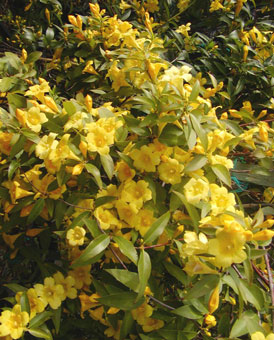Carolina Jasmine
Gelsemium sempervirens
...for a fragrant, early blooming perennial vine
 |
Common names: Carolina Jasmine, Carolina Jessamine, False Jessamine, Yellow Jessamine
Latin Name:Gelsemium sempervirens
Design Tips: Secure young tendrils to structures at planting time to train future growths to climb trellising, arbors and tree trunks. Sections of vine-covered trellis can soften wood or wrought iron fencing. When grown without vertical supports, it can drape elegantly over terraced walls or cascade down the sides of containers. When grown near entryways, the late-winter bloom will fragrance patios, decks, paths and porches with the sent of jasmine.
Form: With age, the sprawling tendrils are inclined to twine around each other until the plant becomes more of a shrub than a filigreed vine, if not thinned out every two to three years.
Size: Each plant can grow 10 to 20 feet tall, dependent on the height of its vertical support.Without vertical support, it creates a 3 to 4 foot dense thicket.
Flowers: Fragrant 1 inch golden yellow trumpets almost smother the plant in late winter and early spring. A second, sparser bloom may occur in mild autumn weather.
Foliage: The lustrous green ovalleaves are 1 to 3 inches long by ½" wide, during the growing season, developing a slight yellow-green or purple-green cast in winter.
Culture: Plant from 1-gallon or larger containers during cool weather in a well-drained, acidic to neutral pH soil rich in organic matter. Similar to clematis, Carolina jasmine prefers a cool, moist root zone with its face in the sun, although it will tolerate some shade and occasional droughts. Monthly feedings during the growing season will speed quick coverage, but need be ceased in fall.
Hardiness: Hardy in USDA Zones 7B through 9, the vine tolerates frosts and short-lived spells down to 15 degrees F, but will not survive long-term freezing temperatures.
Grooming: Prune immediately after flowering to remove dead or broken branches and to shape and thin the overall plant. Make cuts 3 or 4 bud joints beyond old, woody stems to induce new shoots on younger growths.
Propagation: New plants may be produced by air layering, from stem cuttings taken in spring from one year old growths, or from seeds in spring.
Snippets: These trailing or climbing native vines grow wild in open woodlands and thickets along roadsides in Central America and the southeastern United States from Virginia to Florida, and west to Texas and it is the State Flower of South Carolina. Its common name of False Jessamine stems from the descriptive botanical name of Gelsemium, which refers to its jasmine-like bloom fragrance, as gelsemium is Italian for jasmine. Yet, true jasmines are botanically classified under the Latin Jasminums, hence the use of "false" along with the jessamine common name. G. sempervirens 'Pride of Augusta' is a double-flowered cultivar.
Return to Plant Profiles Index Page
Cultivated, photographed and written
by Maggie Ross McNeely in Fort Worth, Texas